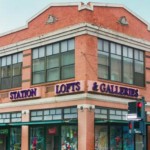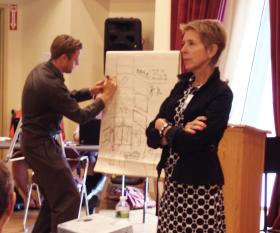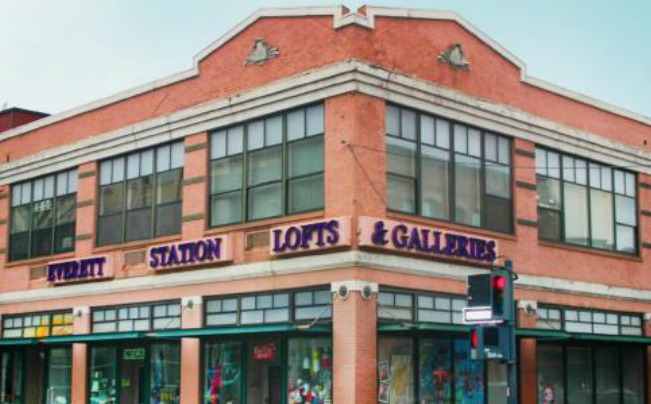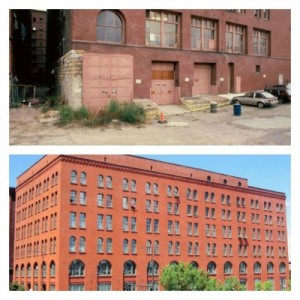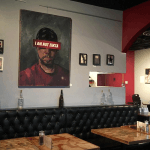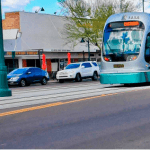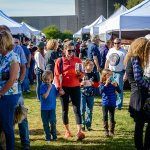There’s a common story that unfolds in cities and towns again and again. Artists looking for cheap rent and spaces to work, move into neglected, transitional areas of town. Their presence and impact begins to transform the area and everything surrounding it. Once scary parts of town become trendy and desirable, and real estate prices begin to rise. The next thing you know, the artists are forced to move elsewhere to find affordable space. And so it goes.
As the vitality of our urban core grows and gathers strength, the desire to live and work here is increasing. How do we nurture growth and density, yet continue to support and embrace artists? One way, is to make sure that there is affordable space for them to continue to live and create in the very neighborhoods that they helped transform.
Artspace is a uniquely successful nonprofit real estate developer whose entire mission is dedicated to creating, fostering and preserving affordable spaces for artists and arts organizations. For three decades they’ve pioneered and built affordable housing for artists. They’ve seen how these projects have advanced public agendas, from job creation, to transit-oriented development, historic preservation and community stabilization and they’ve created a successful process for working with communities that includes a preliminary feasibility visit, an arts market survey, leading to the potential of predevelopment planning or customized consulting.
Because of Artspace’s very specific development experience, the City of Phoenix Office of Arts & Culture, along with Downtown Phoenix, Inc., JP Morgan Chase, Arizona Community Foundation and Arizona Forward invited the Artspace team to Phoenix for a preliminary feasibility visit. On Wednesday and Thursday of last week, Wendy Holmes, Sr. Vice President, Consulting & Strategic Partnerships and and Stacey L. Mickelson, Vice President of Government Relations conducted focus groups with artists, representatives from arts organizations, and the public to learn about the specifics of our community, including the success of the locally-developed Oasis on Grand project in the Grand Avenue Arts District, and begin to suss out additional opportunities for creating sustainable, affordable spaces for artists and arts organization in downtown Phoenix.
“We are pleased that so many people from our arts community turned out for the ArtSpace presentations last week,” said Gail Browne, executive director of the Phoenix Office of Arts and Culture. “Clearly there is a great need for affordable live/work housing for artists in Phoenix.”
To date, Artspace has completed 36 projects in over 14 states, and they are in development on several more, including one in Mesa and another in Avondale. Many of their developments have been adaptive reuse projects. Some are combinations of old and new build elements, while others are all new builds. They are scattered in small and large cities throughout the country and many were built to accommodate artists and their families and include multiple two-and three-bedroom units.
“An Artspace project in Phoenix would provide affordable housing to the creative community, which is sorely needed,” said Diane Brossart, president & ceo of Arizona Forward, a nonprofit partner in bringing Artspace to Phoenix. “Artspace has a track record of creating sustainable projects across the country that stand the test of time – they are sustainable live/work environments that support the arts community.”
Most of the Artspace projects combine housing and studio or rehearsal space for artists with community spaces for performances and exhibitions, spaces for arts organizations, or spaces for small commercial enterprises. Holmes points out that “these businesses can be arts-related, or they can be simply arts-compatible.” One example she noted was a project with artist housing, studio spaces, and commercial spaces, including a daycare business. Not an arts business, but definitely arts-compatible.
This notion of a business being arts-compatible is worth thinking harder about as we plan how we want our downtown to grow. What elements work together and truly support the downtown we want, and which are at cross-purposes? And where do artists fit into the mix?
As the Roosevelt Row area has witnessed in recent months, there are strong feelings about what kind of development will be compatible with the lively artistic vibe of the area. Everyone who has invested in this neighborhood is passionate about what should be built on the shoulders of the artists who’ve spent a couple of decades making it their home. Will it nurture the artists in the area, or make it impossible for them to continue to live there? Whatever comes of the debate being waged over development on 2nd Street, the tensions and the passions are part of the growing pains of a city in the process of transforming itself, and not just in the Roosevelt Row Arts Distric, but in downtown overall.
As we temporarily activate empty lots, adaptively reuse historic structures, celebrate new highrise apartment complexes, and loudly proclaim our longing for mixed-use development, the unique experience and expertise of Artspace may be able to help us effectively create and develop affordable spaces that will keep artists working their magic in the heart of our city. As the process proceeds, we’ll keep you up-to-date on the progress and opportunities.


